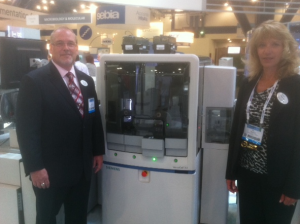Bigger isn’t always better, but faster is often the road to a good result. So when Siemens Healthcare unveiled its latest innovation in clinical laboratory automation Wednesday, it was reassuring to customers that the unit is the size of a small refrigerator. The new iteration of the of the company’s longstanding VersaCell System, the VersaCell X3 Solution, is proof that good things can come in (relatively) small packages.
Bigger isn’t always better, but faster is often the road to a good result. So when Siemens Healthcare unveiled its latest innovation in clinical laboratory automation Wednesday, it was reassuring to customers that the unit is the size of a small refrigerator. The new iteration of the of the company’s longstanding VersaCell System, the VersaCell X3 Solution, is proof that good things can come in (relatively) small packages. The new system offers multi-instrument connectivity, quick results and is designed to make labs more productive.
The VersaCell X3 made its debut at the 64th annual meeting of the American Association for Clinical Chemistry (AACC) in Houston, Texas, where everything is bigger — including the withering heat and humidity. On hand was Siemens Healthcare Diagnostics executive Dave Hickey and two lab officials from Florida-based Martin Health System, long-standing users of several Siemens laboratory automation solutions. “Medical laboratories are still constrained by tight budgets and limited resources, so labs have to target process and meet higher demand,” said Hickey. “The VersaCell X3 Solution is the first system to offer three-instrument connectivity and brings clinical chemistry and immunoassay together in various suites.”
For budget-constrained labs where track-based automation might not be the right approach, the VersaCell X3 has a small footprint and upright design, connects up to three Siemens analyzers through a single robotic sample interface for increased productivity gains. By supporting a customized mix of chemistry, immunoassay and/or integrated systems and associated assay menus, VersaCell X3 helps labs reduce operator sample handling, better prioritize staff work and eliminate pre- and post-analytical processing through one-touch management of samples.
Martin Health is a large multi-hospital system in Stuart, Fla. with 3,000 employees and 380 physicians. It performs over one million lab tests each year. Automation has increased both the speed and accuracy of results. Martin laboratory manager Jennifer Calhoun said that the VersaCell system had greatly reduced the “door to discharge” time for emergency room patients, who make up a large part of the health system’s client population. “You pop open the drawer, put the specimen in and press run,” said Calhoun of the system. Lab testing times have been cut in half with the VersaCell system, she added.
The VersaCell X3 solution eliminates manually moving the specimen from one machine analyzer to another — a function performed by a robotic arm. A priority drawer, situated above existing routine sample drawers, provides eight new STAT positions and frees up to 50 sample positions for routine processing, enhancing STAT management and increasing overall sample routing flexibility. The robotic arm has been modified in the X3 to enable it to support both rounded and flat-bottom tubes, and the incorporation of a docking plate reduces service intervention time for all connected systems, increasing uptime so that labs can continue to deliver results to clinicians on time.
Hickey said the VersaCell X3 Solution should help small and medium labs achieve major workflow improvements. This non-Texas-sized automated system appears positioned to have a large impact.